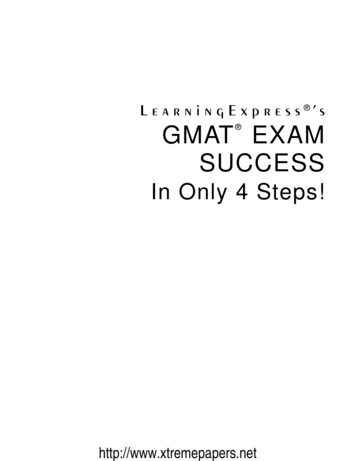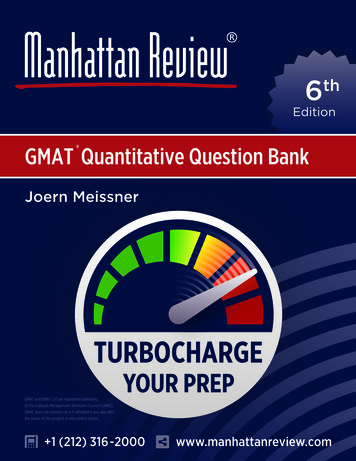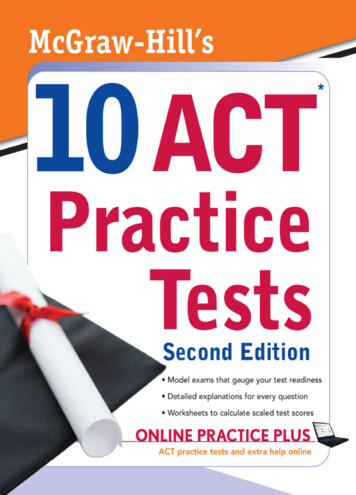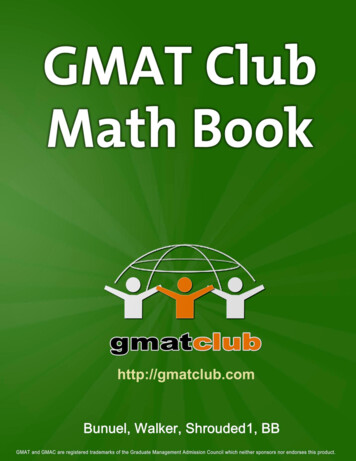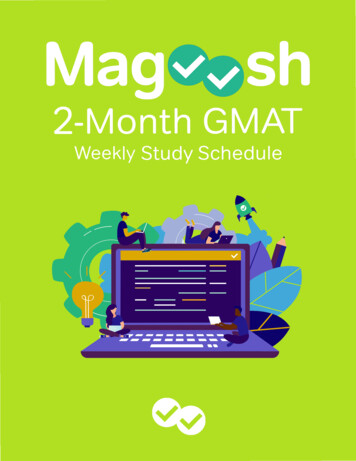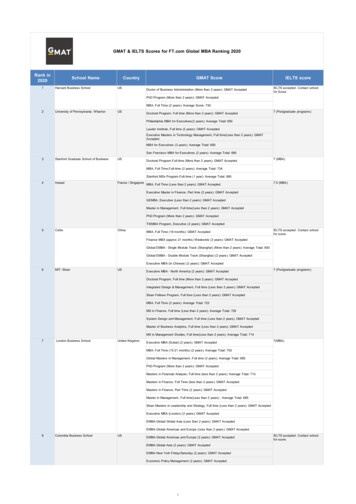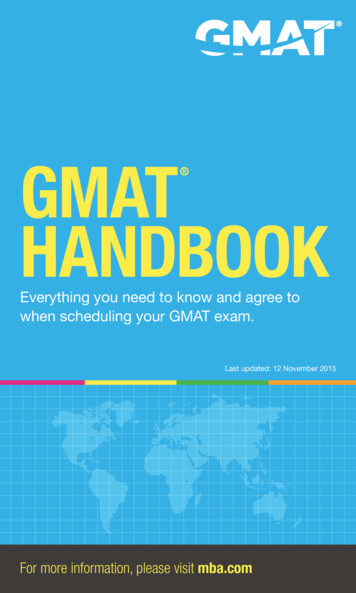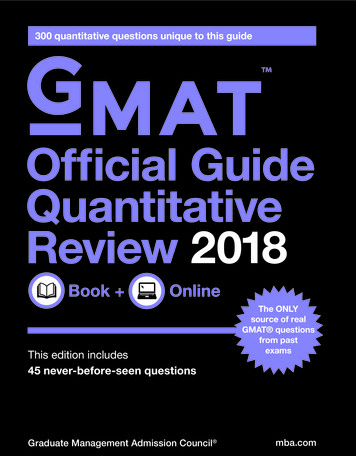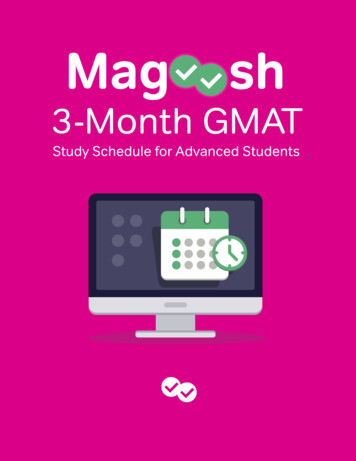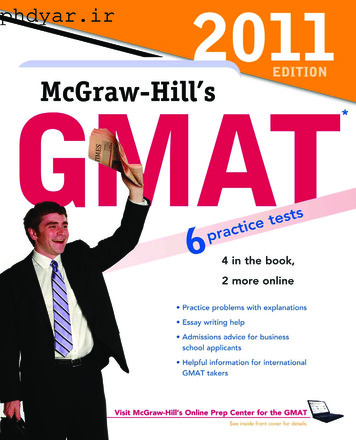
Transcription
phdyar.ir
phdyar.irdMcGraw-Hill’sGMATGRADUATE MANAGEMENT ADMISSION TEST2011 EditionJames HasikStacey RudnickRyan HackneyNew York Chicago San Francisco LisbonLondon Madrid Mexico City Milan New DelhiSan Juan Seoul Singapore Sydney Toronto
phdyar.irCopyright 2010, 2009, 2008, 2007, 2006 by The McGraw-Hill Companies, Inc. All rights reserved. Except as permitted under the United States Copyright Act of1976, no part of this publication may be reproduced or distributed in any form or by any means, or stored in a database or retrieval system, without the prior writtenpermission of the publisher.ISBN: 978-0-07-174030-2MHID: 0-07-174030-9The material in this eBook also appears in the print version of this title: ISBN: 978-0-07-174029-6, MHID: 0-07-174029-5.All trademarks are trademarks of their respective owners. Rather than put a trademark symbol after every occurrence of a trademarked name, we use names in aneditorial fashion only, and to the benefit of the trademark owner, with no intention of infringement of the trademark. Where such designations appear in this book, theyhave been printed with initial caps.McGraw-Hill eBooks are available at special quantity discounts to use as premiums and sales promotions, or for use in corporate training programs. To contact aresentative please e-mail us at bulksales@mcgraw-hill.com.This publication is designed to provide accurate and authoritative information in regard to the subject matter covered. It is sold with the understanding that neither theauthors nor the publisher are engaged in rendering legal, accounting, or other professional services. If legal advice or other expert assistance is required, the servicesof a competent professional person should be sought.—From a Declaration of Principles jointly adoptedby a Committee of the American BarAssociation and a Committee of Publishers.TERMS OF USEThis is a copyrighted work and The McGraw-Hill Companies, Inc. (“McGrawHill”) and its licensors reserve all rights in and to the work. Use of this work is subjectto these terms. Except as permitted under the Copyright Act of 1976 and the right to store and retrieve one copy of the work, you may not decompile, disassemble,reverse engineer, reproduce, modify, create derivative works based upon, transmit, distribute, disseminate, sell, publish or sublicense the work or any part of it withoutMcGraw-Hill’s prior consent. You may use the work for your own noncommercial and personal use; any other use of the work is strictly prohibited. Your right to usethe work may be terminated if you fail to comply with these terms.THE WORK IS PROVIDED “AS IS.” McGRAW-HILL AND ITS LICENSORS MAKE NO GUARANTEES OR WARRANTIES AS TO THE ACCURACY,ADEQUACY OR COMPLETENESS OF OR RESULTS TO BE OBTAINED FROM USING THE WORK, INCLUDING ANY INFORMATION THAT CANBE ACCESSED THROUGH THE WORK VIA HYPERLINK OR OTHERWISE, AND EXPRESSLY DISCLAIM ANY WARRANTY, EXPRESS OR IMPLIED,INCLUDING BUT NOT LIMITED TO IMPLIED WARRANTIES OF MERCHANTABILITY OR FITNESS FOR A PARTICULAR PURPOSE. McGraw-Hill andits licensors do not warrant or guarantee that the functions contained in the work will meet your requirements or that its operation will be uninterrupted or error free.Neither McGraw-Hill nor its licensors shall be liable to you or anyone else for any inaccuracy, error or omission, regardless of cause, in the work or for any damagesresulting therefrom. McGraw-Hill has no responsibility for the content of any information accessed through the work. Under no circumstances shall McGraw-Hill and/or its licensors be liable for any indirect, incidental, special, punitive, consequential or similar damages that result from the use of or inability to use the work, even ifany of them has been advised of the possibility of such damages. This limitation of liability shall apply to any claim or cause whatsoever whether such claim or causearises in contract, tort or otherwise.
phdyar.irContentsForeword .viiMcGraw-Hill’s GMAT: Introduction .ix@Welcome to the GMAT @Attaining Your Competitive Edge: McGraw-Hill’s GMAT@Meet the GMAT @Registering for the GMAT @Additional Practice @Some Final AdvicePART ONECHAPTER 1THE QUANTITATIVE SECTIONThe Techniques of GMAT Problem–Solving .3@The Answers: Not Necessarily Your Friends@Problem-Solving TipsCHAPTER 2Data Sufficiency .9@Introduction @AD or BCE @The Intent Behind the Question Type@Working Data Sufficiency Problems Efficiently @Practice ProblemsCHAPTER 3Basic Principles of Numbers .23@Introduction @Number Terminology @Algebraic Notation and the Order of Operations@Exponents and Roots @Factoring Numbers @Working with Nonintegers@Key Concepts to Remember @Practice ProblemsCHAPTER 4Algebra .43@Introduction @Quadratics @FOIL@Practice ProblemsCHAPTER 5Probability and Statistics .53@Introduction @The Mean @The Median @The Mode @The Range@Calculating the Standard Deviation @What You Need to Remember@Application Problems—Statistics @Probability @Practice Problemsiii
phdyar.irCHAPTER 6GMAT Geometry .75@Introduction @Parallel and Intersecting Lines @Types of Triangles and Their Attributes@Quadrilaterals @Circles @Volume of Boxes and Right Circular Cylinders @What You Need to Remember@Practice ProblemsCHAPTER 7Boolean Problems and Combinatorics.95@Introduction @Boolean Problems on the GMAT@Combinatorics Problems: Two Approaches @Practice ProblemsPART TWOCHAPTER 8THE VERBAL AND WRITING SECTIONSCritical Reasoning .109@Introduction @Critical Reasoning Reading @What Is an Argument? @Assumption Questions@Weaken the Argument @Strengthen the Argument @Inference Questions@Less Common Question Types @The Art of Wrong Answers @Practice Arguments@Practice ProblemsCHAPTER 9Sentence Correction .131@Introduction @Verbs: Where the Action Is @Pronouns: In Place of the Right Answer@Misplaced Modifiers @Parallelism @Idiomatic Expressions@False Comparisons: Apples and Oranges @Quantity @Rare Errors@The Most Common Type of Error @How to Approach a Hard Question@Further Study @Practice Sentences @Practice ProblemsCHAPTER 10Reading Comprehension .151@Introduction @Reading Comprehension Strategy @Passage Topics @Passage Structures@Question Types @Strategic Reading @Answering the Questions: Focused Reading@The Art of the Wrong Answer @Practice ProblemsCHAPTER 11The Analytical Writing Assessment .169@Introduction @How the Analytical Writing Assessment Is Used@How to Approach the AWA @How the Writing Assessment Is Scored@Factors That Can Help or Hurt Your Score @Maximizing Your Score@Analysis of an Issue @Analysis of an Argument @Practice EssaysPART THREECHAPTER 12BEYOND THE GMATChoosing the Right Program .185@Introduction @Choosing a School: Considering Your Objectivesiv#CONTENTS
phdyar.ir@A Brief Taxonomy of MBA Program Types@A Brief Bibliography of School Ratings Lists @Selecting a Portfolio of SchoolsCHAPTER 13Getting Admitted .193@The Importance of the GMAT in Admissions @The Importance of Your Past University Transcripts@Researching the Programs @Preparing Your Résumé @Soliciting the Right Recommendations@Requesting an Interview @Writing Some Compelling Essays @Thinking About Your Career PlanDuring the Admission ProcessCHAPTER 14Getting Ready to Survive B-School .205@Concepts to Remember from Your GMAT Preparation @Math Camp@Essential Tools for the MBA StudentCHAPTER 15Recruiting and Career Management .209@Introduction @The Importance of the GMAT to Recruiters @Planning Your Job Search @Tools forCareer Management @Preparing Your Cover Letters @Thank-you Notes @Interviews @Finishing Upand Looking Back @Networking @Selecting the Right Offer @Will the GMAT Ever Haunt You Again?PART FOURTHE PRACTICE TESTSInstructions for the GMAT Practice Tests .228Practice Tests .229@Practice Test 1 @Practice Test 2 @Practice Test 3 @Practice Test 4Answer Keys .307@Practice Test 1 @Practice Test 2 @Practice Test 3 @Practice Test 4Answers and Explanations.311@Practice Test 1 @Practice Test 2 @Practice Test 3 @Practice Test 4Answer Sheets .395CONTENTS v
phdyar.irThis page intentionally left blank
phdyar.irForewordCongratulations! By purchasing this book, you are taking the first step to one of the best decisions you can make—an investment in yourself! In today’s intensely competitive businessenvironment, it is critically important that individuals who want to advance in their careerscontinue to learn—and obtaining an MBA degree is one of the most effective ways for you tostrengthen your analytical and business acumen.The MBA is a fantastic degree—it will prepare you to pursue a wide variety of careeroptions—and even years after graduation the coursework you have completed in an MBAProgram will have given you the breadth of business perspective to switch from marketing toconsulting or vice versa, as well as to take on the broad responsibilities of a CEO!As part of the application process to an MBA Program, you will need to take the GraduateManagement Admissions Test (GMAT). As I’m sure you know, the GMAT is a challenging standardized test and therefore you owe it to yourself to present a GMAT score which representsyour “best effort.” While your GMAT score results will be but one factor that selective businessschools consider when reviewing your application file, for many MBA Programs, andcertainly the world’s most selective business schools, your GMAT results are a key element inreviewing your application file. The other key factors in making an admissions decision arethe quality of your work experience, academic record, recommendation letters and essays, aswell as your interpersonal qualities, in particular your demonstrated leadership skills.You should also know that a strong score on the GMAT can make a big difference, not onlyin whether or not you are admitted to a top-tier MBA Program, but that, if admitted, it cangreatly enhance the probability that you will receive a scholarship. Essentially, a strong GMATscore, in combination with progressive work experience, solid undergraduate grades, and apositive interview can be the difference between admission to none of your desired MBAprograms, and the chance to choose between several attractive MBA Program options.McGraw-Hill’s GMAT will provide you with a template to help you best prepare to takethis challenging test. I urge you to make this investment in yourself—to pursue an MBA—andthe first step along this path is to prepare wisely to take the GMAT. This book will give you thetools, techniques and insight into the design of the GMAT so that you can adequately preparefor the test. I have known Jim Hasik for many years and he is a bright and engaging GMATpreparatory teacher. However, what I have always admired most about Jim is that he takes agenuine interest in his students and this same approach is evident in his writings. StaceyRudnick has contributed her considerable talents and expertise to this book as well. As anMBA career services professional, she brings a deep understanding of the MBA marketplaceand a real appreciation for the skills set desired by the most selective MBA Programs and themost prestigious hiring firms. She has worked not only as a Brand Manager for Kodak but alsovii
phdyar.irin the career services office for two Top 20 MBA Programs. In addition, while an MBA student atGoizueta Business School, Stacey was one of our most talented student leaders. Co-author RyanHackney is a professional writer specializing in educational content. He has two degrees from HarvardUniversity and has worked for the Boston Consulting Group and for an Internet startup.Jim, Stacey, and Ryan have written this book in a straightforward and easy-to-read manner. It isnot designed to teach you everything you ever wanted to know about the GMAT—but instead, is written to tell you everything that you need to know to most effectively prepare for the test. As you prepareto take the GMAT, McGraw-Hill’s GMAT is an ideal place to start. In order to realize your best score, itis critically important that you know the following prior to taking the GMAT. Understand how the computer-based GMAT is designed and how the test will conform to yourspecific skill levels Understand the format of the verbal section questions and the types of analytical problemsyou will need to solve Understand the math concepts that you will need to know to perform well on the analytical sections Understand the structure of the writing assessment instrument and how you will be gradedThis book will address all these issues and more. For individuals who completed few quantitativecourses in college, or those who lack confidence about their math skills, the math review chapters willbe especially important. You should know that MBA Admissions Committees at most top-tier MBAPrograms place particular emphasis on an applicant’s quantitative test results. Conversely, if verbalreasoning skills or reading comprehension are not your strong suit, you should spend more timepreparing for those sections of the test.In addition to the theoretical and analytical skills set that MBA studies teach, one of the mostvaluable aspects of the MBA degree is the lifelong friendships that the MBA Program experienceoffers. Whether you go to a full-time, part-time, or an Executive MBA Program, your classmates andteammates will make an indelible mark on your thinking—and many will become your lifelongfriends. From my own personal experience, I know this to be true.For the past 21 years, since my own graduation from the University of North Carolina’s MBAProgram, I have spent each Labor Day weekend with the six members of my MBA Program studygroup and their families—it is a time for renewing our friendship. In my 17 years at Emory’s GoizuetaBusiness School I have found the same to be true. I frequently speak with Goizueta alumni, andwhether I’m in New York City or Seoul, they speak fondly of seeing classmates at weddings, of newbusiness ventures developed with teammates, and of visiting alumni during their business andpersonal travels throughout the globe. The MBA Program experience is designed to change andstretch you beyond your comfort zone and it will definitely accomplish that objective. However, it isthe network that you build through MBA studies that is the most rewarding aspect of the experience.Good luck to you on the GMAT and in the MBA application process afterwards, and again,congratulations on your decision to make such a wise investment in yourself.Sincerely,Julie R. BarefootAssociate Dean and Director of MBA AdmissionsGoizueta Business SchoolEmory UniversityAtlanta, Georgia, USAviii#FOREWORD
phdyar.irMcGraw-Hill’s GMAT: IntroductionWELCOME TO THE GMATWelcome to the GMAT. Were we saying this to you in person, we might duck after speakingthose words. For many people, there’s nothing remotely welcoming about the GMAT. To manybusiness school applicants, the test appears to be the most painful hurdle they must clear intheir admissions process, and the one for which their work experience has left them the leastprepared.Yet still they come: tens of thousands of people take the GMAT every year, subjectingthemselves to three and a half hours of questions about linear equations, statistics, logic,English syntax, and just what the writer of that obscure passage meant by “shibboleth.” TheGMAT can be irritating, but like it or not, it’s an unavoidable bump on the path to an MBA.And it doesn’t have to be your enemy; a high score on the GMAT can help pave the way to a spotin a top business school, which could lead to a very lucrative and rewarding career in brandmanagement, consulting, investment banking, starting your own business . . . but we’regetting ahead of ourselves. You know why you have to take the GMAT. It’s our business to helpyou make your GMAT score a strong point on your application.The GMAT tests skills that you use all the time; it just tests them in ways that you probably never encounter in the real world. Every day of your life, you seek out information,analyze arguments, and compare quantities and values. If you’ve graduated from college, youshould have been exposed at least once in your life to almost all of the mathematics andsyntax concepts that are tested on the GMAT. Your success on the GMAT will be determinedin large part by how well you can marshal these skills and half-forgotten concepts for the veryspecific types of problems presented by the GMAT. This book will help you do just that.ATTAINING YOUR COMPETITIVE EDGE: McGraw-Hill’s GMATBroadly speaking, success in business comes from effectively executing a strategy to attain acompetitive edge. What you are looking for in your application to business school is acompetitive edge; the GMAT is, after all, a competition between you and every other B-schoolcandidate in the country. There can be a lot of winners in this competition, but you will becompared to each of them, so you must develop a strategy that will help you attain yourcompetitive edge on this vital aspect of the application process. This book will help youdevelop two different strategies: first, a strategy of preparation for the days, weeks, or monthsbefore you take the test; and second, a strategy of execution for when you walk into the testing center and sit down at the keyboard.ix
phdyar.irMcGraw-Hill’s GMAT presents information tailored to those test takers who are hoping for a highscore—a score in the mid-600s or higher that will open the doors to the top business schools. Whilethis book presents information on the entire range of subjects and difficulty levels encountered inGMAT questions, we have placed special emphasis on addressing the more difficult question typesthat high-scoring test takers are more likely to see, such as combinatorics, Boolean mathematics, andparallel reasoning questions. We have observed that the majority of GMAT books on the market todayare engineered to provide a medium-sized bump to a medium-range score, and they just don’t getaround to addressing the more difficult topics. This book seeks to help applicants develop a competitive edge in their quest to enter the most competitive business schools.We have also gone a step further and provided you with four chapters to help with the rest of yourB-school preparation process. We cover the questions you should ask in selecting a school, the preparation that is needed for the rest of your application (there is more to this than the GMAT), what toexpect in graduate business school, and how to think about your job search from the vantage point ofan applicant. MBA programs are more than graduate study—they’re professional study—so the pointof this, after all, is the rewarding and lucrative job that you will land on the other end.MEET THE GMATPlease allow us to introduce you to your new friend, the GMAT. The GMAT is a three-and-a-half-hourwriting and multiple-choice test. For many years GMAT test forms were created by EducationalTesting Service (ETS), a private company based in Princeton, New Jersey. ETS is famous as the creatorof the SAT. However, since January 2006, creating new GMAT test forms has been the job of ACT, Inc.,an Iowa-based company that also develops a well-known college admission exam. ACT designs theGMAT in coordination with the Graduate Management Admission Council (GMAC), a consortium ofbusiness schools with its headquarters in McLean, Virginia. GMAC provides ACT with guidelinesabout the type of information business schools are looking for from the GMAT, and ACT turns theseguidelines into the test you are going to encounter in the near future.Administering the test is the job of still another company, called Pearson VUE. This company isthe electronic testing division of Pearson Education.What You Will SeeYou will probably take the GMAT on a computer at a Pearson VUE test center. You’ll get the specificsabout where and when that will be when you register for the test (more on registration at the end ofthis chapter). The parts of the test are as follows:SectionNumber of QuestionsAnalytical WritingAssessmentAnalytical WritingAssessmentOptional BreakQuantitative1 “Analysis of an Issue”301 “Analysis of an Argument”3037 Multiple-Choice 15 Data Sufficiency 22 Problem-SolvingNumber of Minutes1075Continuedx#INTRODUCTION
phdyar.irSectionOptional BreakVerbalNumber of Questions41 Multiple-Choice 12 Critical Reasoning 14 Reading Comprehension 15 Sentence CorrectionNumber of Minutes1075Each of these test sections is covered in detail in the chapters of this book. Add up the minutesand the number of different types of questions you’re going to face. When you take the test, you willspend about four hours in the testing center furiously analyzing, writing, computing, reading, scribbling, reasoning, and, almost certainly, guessing. It’s not an easy test—if it were, business schoolswouldn’t use it. But with the proper preparation, you can handle it and make your score work for you.How the GMAT Is ScoredWhen you finish the multiple-choice sections of the GMAT, the computer will take about an eighth ofa second to calculate your score on those sections. You will then have a choice of either seeing yourscore—in which case it will be official—or canceling your score without seeing it. Your full score willinclude:1. Your quantitative score, from 0 to 602. Your verbal score, from 0 to 603. Your overall score, from 200 to 800, in increments of 104. Your score on the Analytical Writing Assessment, from 1 to 6 in half-point increments (thisscore requires a human grader, so it will arrive in the mail a few weeks after you take the GMAT)Your overall score is the one that people generally think of as your “GMAT score.” While it is themost important aspect of your GMAT score from a business school’s perspective, admissions officialswill almost certainly look at the other score components, the quantitative score in particular, in orderto see how balanced a candidate you are. All four scores will also come with a correspondingpercentile number indicating where your score stands in relation to those of all GMAT test takers.The Computer-Adaptive GMATThe computer-adaptive GMAT is not the same test as the old paper-based GMAT. When you take thetest on a computer, the computer gives you different questions based on how many of the previousquestions you have answered correctly. It begins by giving you a question of medium difficulty—which means that ACT expects roughly half of the test takers to answer it correctly and half to get itwrong—and if you answer it correctly, the computer will give you a harder question; if you answer itincorrectly, the computer will give you an easier question. As you answer more questions, the computerwill refine its picture of the level of difficulty you are capable of handling. By the end of the test, itshould, theoretically, present you with questions at a level of difficulty where you get about half thequestions right and half wrong (unless you’re heading for either a very high or a very low score).Obviously, the higher the level of difficulty at which you end a test section, the higher your score willbe. You want to see hard questions.INTRODUCTION xi
phdyar.irThere are a number of reasons why the test makers switched to the computer-adaptive test (hereafterCAT). First, it greatly expands the flexibility of time and place at which a person can take the test;under the old system, there were only a few opportunities per year to take the GMAT. Second, sinceeach person receives what is essentially a unique test, there is much less concern about cheating. Third,the CAT is theoretically a more accurate measure of a test taker’s abilities than the old paper-based test.There are some trade-offs, however, that make the CAT in some ways a more difficult test to preparefor than the old test.The nature of the CAT means that you will need to employ different strategies to attain yourdesired score than you would have used for the paper test:1. The early questions are crucial. On a paper test, all the questions are valued equally, but on theCAT, the earlier questions play a much larger role than the later questions in determining yourscore range. Answering the first five questions correctly is far more valuable to your score thananswering the last five questions correctly, because by the end of the test the CAT has alreadypretty much decided the general area where your score is going to be. If, for example, you cananswer eight or more of the first ten questions correctly, the CAT will peg you as a strong testtaker and will give you more difficult questions for the rest of the test. It is worthwhile to budgetextra time for the early questions in order to get them right, even if this means you have to guesson some questions at the end. More on guessing later.2. You can’t skip. The CAT gives you questions based on the results of prior questions, so it willnot allow you to skip questions and go back to them later. Technically, you can just go pasta question without answering it, but this will count against your score. For this reason, youare better off making your best guess and possibly getting the points for a correct answer. It isin your best interests to answer every question in every section, even if this means you haveto guess.3. You can’t write on the test. You can use scratch paper, so you will need to train yourself to usescratch paper effectively. Using scratch paper is less efficient than writing and crossing outanswers on the test paper itself, so do not allow yourself to get into the habit of writing on thetests provided in this or other books. In your practice, always try to recreate the conditions ofthe actual test as closely as possible. Many test takers find it is helpful to make an answer gridso that they can keep track of which answer choices they have eliminated. It could look like EEEEE4. You have to type the Analytical Writing Assessment essays. This could be an advantage for you ifyou are a good typist, but it could be a handicap if you don’t often type. See more in Chapter 11,“The Analytical Writing Assessment.”xii#INTRODUCTION
phdyar.irREGISTERING FOR THE GMATOne advantage of the CAT is that the GMAT is now far easier to register for than it was in the past. Justgrab a credit card or your checkbook and either call up 1-800-717-GMAT or go online atwww.mba.com. The registration fee as of late 2009 was 250. Call several weeks ahead of time in orderto get the date and time of day you want. You can choose either a morning or an afternoon slot, so pickthe time of day you think your mind will be at its best. GMAC will give you all the information youneed to show up for your testing slot.ADDITIONAL PRACTICEIf you seek additional practice on the GMAT, the first place to look is the source itself. On the Web sitewww.mba.com, you’ll find some computer-based practice tests that use questions from oldGMATs. These tests will provide you with a very authentic test experience.SOME FINAL ADVICE Read all questions carefully. Give extra attention to the early questions. Keep track of your pace (average about two minutes per question). Use process of elimination to guess strategically if you run short on time. Practice! Keep calm! Good luck!INTRODUCTION xiii
phdyar.irThis page intentionally left blank
phdyar.irfTheQuantitativeSectionPART ONE
phdyar.irThis page intentionally left blank
phdyar.irCHAPTER 1The Techniques of GMATProblem-SolvingdYou are going to see more Quantitative Problem-Solving questions than any other type ofquestion on the GMAT, around 22 out of the 37 Quantitative problems on the test.These questions cover a wide range of mathematical concepts that you almost certainlyencountered in high school, but that you might not have studied since. A very easy ProblemSolving question could look like this:1. A certain standardized test taken by business school applicants demands that the testtakers answer 37 quantitative questions within 75 minutes. Which of the following isclosest to the average amount of time the test takers can spend on each question?A. 1 minute,
Contents Foreword.vii McGraw-Hill's GMAT: Introduction.ix @Welcome to the GMAT @Attaining Your Competitive Edge: McGraw-Hill's GMAT @Meet the GMAT @Registering for the GMAT @Additional Practice @Some Final Advice
